- Home
- About
- Map
- Trips
- Bringing Boat West
- Migration West
- Solo Motorcycle Ride
- Final Family XC Trip
- Colorado Rockies
- Graduates' XC Trip
- Yosemite & Nevada
- Colorado & Utah
- Best of Utah
- Southern Loop
- Pacific Northwest
- Northern Loop
- Los Angeles to NYC
- East Coast Trips
- 1 Week in Quebec
- Southeast Coast
- NH Backpacking
- Martha's Vineyard
- Canadian Maritimes
- Ocracoke Island
- Edisto Island
- First Landing '02
- Hunting Island '02
- Stowe in Winter
- Hunting Island '01
- Lake Placid
- Chesapeake
- Provincetown
- Hunting Island '00
- Acadia in Winter
- Boston Suburbs
- Niagara Falls
- First Landing '99
- Cape Hatteras
- West Coast Trips
- Maui
- Mojave 4WD Course
- Colorado River Rafting
- Bishop & Death Valley
- Kauai
- Yosemite Fall
- Utah Off-Road
- Lost Coast
- Yosemite Valley
- Arizona and New Mexico
- Pescadero & Capitola
- Bishop & Death Valley
- San Diego, Anza Borrego, Joshua Tree
- Carmel
- Death Valley in Fall
- Yosemite in the Fall
- Pacific Northwest
- Utah Off-Roading
- Southern CA Deserts
- Yosemite & Covid
- Lake Powell Covid
- Eastern Sierra & Covid
- Bishop & Death Valley
- Central & SE Oregon
- Mojave Road
- Eastern Sierra
- Trinity Alps
- Tuolumne Meadows
- Lake Powell Boating
- Eastern Sierra
- Yosemite Winter
- Hawaii
- 4WD Eastern Sierra
- 4WD Death Valley +
- Southern CA Deserts
- Christmas in Tahoe
- Yosemite & Pinnacles
- Totality
- Yosemite & Sierra
- Yosemite Christmas
- Yosemite, San Diego
- Yosemite & North CA
- Seattle to Sierra
- Southwest Deserts
- Yosemite & Sierra
- Pacific Northwest
- Yosemite & South CA
- Pacific Northwest
- Northern California
- Southern Alaska
- Vancouver Island
- International Trips
- Index
- Tips
- Books
- Photos/Videos
- Search
- Contact
Barcelona
Monday, June 17, 2019 - 8:15am by Lolo66 miles and 1.5 hours from our last stop - 1 night stay
Travelogue
 Parc de la Ciutadella's "Cascada," an ornamental fountain designed by GaudiIt had all come full circle and we were back in Motel One in Barcelona where our journey had begun. We had arrived four weeks ago - two wide-eyed, enthusiastic tourists ready to take on Spain. Those eyes were a bit wearier now after a pretty fast-paced month, but our enthusiasm for this lovely country had not diminished.
Parc de la Ciutadella's "Cascada," an ornamental fountain designed by GaudiIt had all come full circle and we were back in Motel One in Barcelona where our journey had begun. We had arrived four weeks ago - two wide-eyed, enthusiastic tourists ready to take on Spain. Those eyes were a bit wearier now after a pretty fast-paced month, but our enthusiasm for this lovely country had not diminished.
We had briefly considered staying in an airport hotel for our last night, but it’s so convenient getting to the airport from the city that we decided it would be much more fun to return to Barcelona.
During our 4-day stay at the beginning, we had covered a lot of ground, but there were still a few things we had missed.
 View from our hotel rooftop in BarcelonaOne of those was the Parc de la Ciutadella (Citadel Park), literally right across the street from our hotel. This lovely green oasis is Barcelona’s largest park and the site of the 1888 Barcelona Universal Exposition, Spain’s first International World’s Fair.
View from our hotel rooftop in BarcelonaOne of those was the Parc de la Ciutadella (Citadel Park), literally right across the street from our hotel. This lovely green oasis is Barcelona’s largest park and the site of the 1888 Barcelona Universal Exposition, Spain’s first International World’s Fair.
So, we decided to take a stroll. One of the most beautiful things in the park is the ornamental fountain, known as “Cascada.” It was designed by the then unknown architect, Antoni Gaudi, who went on to make such a big mark on this city’s incredible architecture. His signature winged dragons guard the fountain.
Just beyond the fountain is a lovely little lake where you can rent rowboats. There is also a zoo, an art museum, a greenhouse, and a winter garden to explore.
 Goodbye lovely BarcelonaWe continued on through the park and eventually wound up on the Barceloneta again, Barcelona’s fabulous man-made beach, where Barcelonians like to recreate.
Goodbye lovely BarcelonaWe continued on through the park and eventually wound up on the Barceloneta again, Barcelona’s fabulous man-made beach, where Barcelonians like to recreate.
There were so many places to eat by the Barceloneta and Parc, but we decided to try a quieter neighborhood. Herb looked on TripAdvisor and found a highly rated "creative cuisine" just a short walk from our Motel. It was quite tasty and the ambiance was nice.
When we got back at the hotel, we decided to check out the second thing we had missed on our first visit here - the incredible rooftop bar atop Motel One. Why didn’t we know about this before?? There were dozens of comfy chairs and couches to sit on, and the views of the city were phenomenal. It was magical during the golden hour.
A fitting ending to a really wonderful trip.
Description
While I will not attempt to do an in-depth description of all Barcelona has to offer -- there are numerous guidebooks to do just that -- the following are some interesting sites that we enjoyed:
Las Ramblas pedestrian mall - one hour stroll from Playa de Catalunya to the La Rambla del Mar on the waterfront
- Broad pedestrian boulevard with souvenir hawkers, street artists, mimes, living statues, cafes, and shops
- More charming in the morning - grab breakfast at a market cafe
- Along the way:
- Fountain of Canaletes - ornate black and gold lamp post with a fountain at its base. Legend says that a drink from it ensures you will return to Barcelona one day
- Wavy tile work - represents the stream that once flowed here
- Look up to see the city’s characteristic shallow balconies with floor to ceiling windows
- Chairs fixed to the sidewalk at jaunty angles
- Betlem Church - 17th century Baroque church with sloping roofline, ball-topped pinnacles, corkscrew columns
- Rambla of Flowers - flower stands
- La Boqueria Market
- Plaça de la Boqueria - here you will see the Joan Miro mosaic in red, white, yellow, and blue
- Plaça Reial - dotted with palm trees and surrounded by yellow buildings with white trim this placa has old-fashioned taverns as well as modern bars with patio seating
- Palau Guell - apartment building designed by Antoni Gaudi. This was the first of his Modernista buildings, and you can see his emerging nonlinear style in the arches and doorways
- Christopher Columbus monument
- Rambla del Mar - wavy wooden walkway along the waterfront
Barri Gotic (Historic Gothic Quarter) walk - 1.5 hour self-guided tour from Placa de Catalunya to Placa del Rei
- Stroll the narrow Medieval lanes of Barcelona’s enchanting old quarter
- Relics of ancient Rome, 14th century Gothic churches, cobblestone lanes lined with shops, bars, and restaurants
- Along the way:
- Avinguda del Portal de l’Angel - once a major city gate. The angel statue atop the gate was said to keep Barcelonans safe from plagues and bid voyagers a safe journey
- Church of Santa Ana - 12th century Catalan Gothic church
- Els Quatre Gats - circa 1900 bohemian artist hangout, where Picasso had his first one-man show
- Playa Nova - flanked by two Roman towers that once guarded the entrance ate of the ancient Roman city of Barcino
- Barcelona Cathedral - 14th century Flamboyant-style (donation entrance 7 euros)
- Sardana dances, patriotic dance in which Barcelonans link hands and dance in a circle - on Sunday at 11:15 and many Saturdays at 18:00
- Casa del Ardiaca - old mansion that now functions as the city archives
- Carved mail slot (right of door) carved by a 19th century Modernista architect
- From the courtyard, climb to the balcony for views of the cathedral steeple and gargoyles
- Jewish quarter (El Call) - walk along the narrow passages and alleys where 4,000 Jews were forced to live
- Ruins of Roman Temple of Augustus - site where Romans founded the town of Barcino in 12 BC
- Placa del Rei - reminders of Barcelona’s medieval Golden Age
Barceloneta
- Traditional fishing neighborhood with gritty charm and good seafood restaurants
- Gorgeous man-made beach several miles long
- Stroll 4.5 km promenade - from La Estrella Herida to Peix
- La Estrella Herida - Contemporary 33-ft. beach sculpture of 4 stacked leaning steel cubes with windows, by Rebecca Horn.
- Peix (Fish) - giant copper-like Peix (Fish) sculpture by Frank Gehry glitters in the sunlight
La Sagrada Familia - Antoni Gaudi’s grand masterpiece
- Located in Eixample residential neighborhood, 1.5 miles north of Placa de Catalunya
- Hours: Mon - Sat 9:00 am - 8:00 pm; Sun 10:30 am - 8:00 pm)
- Timed-entry tickets - buy in advance: http://www.sagradafamilia.org/en/
- Gaudi labored on the Sagrada Familia for 43 years, from 1883 until his death in 1926. Work continued after his death and the church is expected to be finished in 2026 (a century after his death)
- Exterior
- Currently there are eight 330-foot spires topped with crosses. When completed there will be 18 - 12 representing the apostles, (over the three entrances), 4 taller ones representing the evangelists, an even higher one designated for the Virgin Mary, and the final 18th one, which will be the highest one in the middle, representing Jesus Christ
- The three facades - Nativity, Passion, and Glory, will chronicle Christ’s life from Birth, to crucifixion, to resurrection. Only the Nativity Facade was completed during Gaudi’s lifetime. The Passion Facade was completed in 2006, and the Glory Facade is still under construction
- Interior
- Floor plan is that of a Latin cross, 300 feet long and 200 feet wide - large enough to ultimately accommodate 8,000 worshippers
- The roof is held up by 56 tree-like columns, complete with branches and leaves, creating the effect of a forest canopy
- Sunlight filtering through stained glass windows creates a hypnotic, magical effect of a dappled rainforest canopy. Morning light shines in through blues, greens, and other cool colors, while evening light flows in reds, oranges and other warm tones.
Park Guell - Gaudi’s most ambitious project after Sagrada Familia
- 30 minute walk from Sagrada Familia
- Fanciful and playful space - two Hansel and Gretel gatehouses, dragon guarding a whimsical staircase, wavy benches, and a panoramic view terrace supported by a forest of columns
- Located 2 miles (uphill) to the northwest of Sagrada Familia
- Much of the park is free, except for the Monumental Zone where all the iconic Gaudi features are
- Zona Monumental (open daily 8:00 am to 8:30 pm)
- 400 visitors allowed in each hour
- Timed entry tickets - buy in advance (€ 10)
https://parkguell.barcelona/en/planning-your-visit/prices-and-times
L’Eixample - heart of Barcelona’s Modernista architectural movement
- Located north of the Old City
- Modernista - Free-flowing organic style that lasted from 1888 to 1906. It is characterized by wave-like curves, asymmetry, brightly colored glass and tile, and vegetal and other organic motifs
- Block of Discord - two of Gaudi’s colorful Modernista facades on Passeig de Gracia near the Metro stop)
- Casa Batllo - designed by Gaudi at his hallucinatory best
- Wave-shaped window frames and balconies, mushroom-shaped fireplace, and roof topped with a fanciful dragon-inspired roof
- Open daily from 9:00 am to 9:00 pm (but currently under renovation)
- Timed entry tickets - buy in advance
(€25)https://www.casabatllo.es/venta-entradas/ - La Pedrera (Casa Mila) - one of Gaudi’s trademark works and an icon of Modernisme
- Half hour walk from Park Guell
- Purist Gaudi interior in Barcelona
- One of the most notable elements of the building is the roof, crowned with skylights, staircase exits, fans, and chimneys.
- Open daily from 9:00 am - 8:30 pm
- Timed-entry ticket - buy in advance http://www.lapedrera.com/es/prepara-la-visita/tarifas
Montjuic - Large hill overlooking the city with Romanesque art, a fort, beautiful gardens, and art galleries and museums
- Fundacio Joan Miro (closed Mondays) - Barcelona’s best-looking gallery, set among gardens overlooking the city
- Tues - Sat 10:00 - 8:00, Sun 10:00 - 3:00
- Tickets: €13 https://www.fmirobcn.org/en/visit-us/opening-hours-and-prices/
- Montjuic Castle - at the top with great views of the city
- Dating from the late 17th century, for most of its dark history it has been used as a political prison and killing ground
- Tickets - €5
Picasso Museum - (closed Mondays)
- Set in five contiguous medieval stone mansions
- The collection, which includes more than 3500 of his works, concentrates on his formative years (from age 14 to 23) in Barcelona (pre-1904)
- Tues - Sun 9:00 am - 7:00 pm
- 12 € for timed-entry ticket (buy ahead of time on the museum website)
Parc de la Ciutadella (Citadel Park) - located in La Ribera section of the city (across the street from Motel One)
- Site of the 1888 Barcelona Universal Exposition, Spain's first International World's Fair
- Barcelona’s largest park - its 70-acre grounds include a small lake with rental rowboats, an ornamental fountain (which Antoni Gaudi helped design), the city zoo, a greenhouse, a winter garden, and plenty of green areas to sit and relax
Camping Las Palmeras
Saturday, June 15, 2019 - 9:15am by Lolo140 miles and 2.5 hours from our last stop - 2 night stay
Travelogue
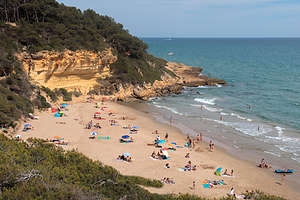 Back to lovely Cala Fonda beachWe were in the final stretch - two more days before we had to return the van. We wanted to be situated somewhat close to MrRent at the end of our trip, so before we left we had reserved two nights at Las Palmeras, a very highly rated campground, right on the Costa Daurada. Herb had even splurged for a beachfront “premium plot” for 29€ per night. He spoils me so.
Back to lovely Cala Fonda beachWe were in the final stretch - two more days before we had to return the van. We wanted to be situated somewhat close to MrRent at the end of our trip, so before we left we had reserved two nights at Las Palmeras, a very highly rated campground, right on the Costa Daurada. Herb had even splurged for a beachfront “premium plot” for 29€ per night. He spoils me so.
When we checked in, we were escorted by a campground associate in a golf cart to our site. They weren’t kidding about beachfront. It was not just “front” but actual beach, with pretty deep sand. Our escort, who spoke absolutely no English, waved his arms a lot while trying to direct us to stay on the very edge of the site near the pavement, where we would at least have a fighting chance of getting out again. Oh well, we would worry about that in two days. At least for now we could here, and probably feel, the surf.
Part of Herb’s campground selection process includes finding great beaches nearby, and this one had the Cala Fonda, but locals call it Waikiki Beach. I can see why.
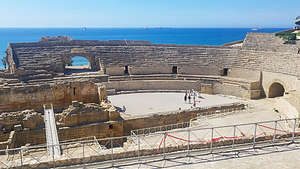 Ruins of a 2nd century AD Roman amphitheater in TarragonaIt required us walking about a mile along the campground beach, which was fairly narrow and very crowded, through a pristine forest, and then a rocky climb down to a sort of secluded cove. It was probably the nicest beach we had been to yet, and that is saying a lot.
Ruins of a 2nd century AD Roman amphitheater in TarragonaIt required us walking about a mile along the campground beach, which was fairly narrow and very crowded, through a pristine forest, and then a rocky climb down to a sort of secluded cove. It was probably the nicest beach we had been to yet, and that is saying a lot.
We spent the afternoon reading, swimming, and people watching. I was especially fascinated with a group of guys in a circle, kicking a soccer ball around. Normally, I would have been concerned about getting hit, as we were pretty close, but they had amazing skills and control. Everywhere we had gone this trip, whether it was on a beach or in a square, guys (from 4 years old to 30) were always doing this. Soccer is obviously a very big deal here. I wondered though why we didn’t see girls doing the same thing.
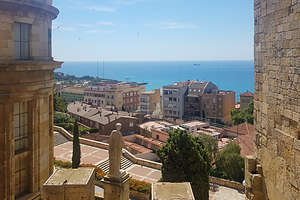 Inside the ruins of a 1st century AD Roman CircusThat evening I took a walk by myself and stumbled upon some campground lively entertainment by the pool. A very enthusiastic dance instructor was leading about 30 very enthusiastic women, of all ages, shapes, and sizes, in some very energetic dance moves. Boy, these people know how to have a good time. I wish Herb had been with me to see it. Maybe he would have wanted to bust a move with the ladies.
Inside the ruins of a 1st century AD Roman CircusThat evening I took a walk by myself and stumbled upon some campground lively entertainment by the pool. A very enthusiastic dance instructor was leading about 30 very enthusiastic women, of all ages, shapes, and sizes, in some very energetic dance moves. Boy, these people know how to have a good time. I wish Herb had been with me to see it. Maybe he would have wanted to bust a move with the ladies.
The next morning, rather than go directly to the beach, we decided to get some exercise in and some culture as well. Tarragona was once one of the most important cities in the Roman Empire. At that time it was known as Tarraco. Today it has some of the best preserved ruins in all of Spain.
Our mission for the morning was to find them. I went into the campground office to ask for directions and was told that we could get to them by walking for about 5 miles on trails along the beach. Sounded perfect.
It was, but it did get a bit confusing at times. However, eventually we found them.
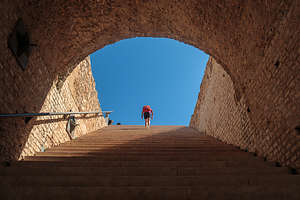 Lolo walking in the footsteps of an ancient Roman gladiatorThe first thing we came across was a pretty well preserved amphitheater cut into a hillside above the beach. The Amfiteatre Roma, as it was known then, was built in the 2nd century AD and used to stage contests and public executions. Since we could pretty much look down on the whole thing, we chose not to take the tour.
Lolo walking in the footsteps of an ancient Roman gladiatorThe first thing we came across was a pretty well preserved amphitheater cut into a hillside above the beach. The Amfiteatre Roma, as it was known then, was built in the 2nd century AD and used to stage contests and public executions. Since we could pretty much look down on the whole thing, we chose not to take the tour.
We did, however, take the tour (3.30€) of the nearby 1st century AD Roman Circus, or Pretori i Circ Romans in Latin. While most of the ancient circus now lies hidden beneath the city, there were some tunnels to talk through that did let us follow in the footsteps of a charioteer entering the hippodrome, which could hold up to 30,000 spectators. Unfortunately, that too is somewhere beneath the current city. Another highlight was climbing to the top of the Praetorium tower for a wonderful panoramic view of the current city of Tarragona.
We thought about walking back to the campground, but we were kind of anxious to get back to our little Waikiki beach and relax for awhile. After all, it was our last night in the van. Instead we got a taxi. It was absolutely the right thing to do.
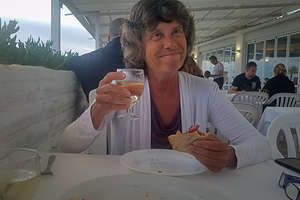 Choosing to have our last dinner in the camper not in the camperWe spent a very pleasant afternoon on our secret cove beach, which wasn’t so secret based on the number of people here.
Choosing to have our last dinner in the camper not in the camperWe spent a very pleasant afternoon on our secret cove beach, which wasn’t so secret based on the number of people here.
Afterwards, we did some cleanup of the camper in preparation for its return, and packing in preparation for ours. We did, however, find time to squeeze in a very nice dinner in another very nice campground restaurant.
This van had been our home for the last month, so it was a little sad to think about saying goodbye to it tomorrow.
Description
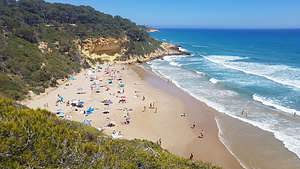 Cala Fonda beach on the Costa DauradaCamping Las Palmeras
Cala Fonda beach on the Costa DauradaCamping Las Palmeras
Wonderful campground in Tarragona on the Costa Durado. The campground has 2 km of beach on the Mediterranean Sea and is in walking distance to Cala Fonda, a small strip of sandy beach backed by a wooded hill, in a secluded, scenic cove.
There is a restaurant with a terrace overlooking the sea, a lovely pool, and musical entertainment on the weekends.
Roman ruins
Tarragona was once one of the most important cities in the Roman Empire. As a result, it is one of the best places to see Roman ruins in Spain. We visited two of them during our stay:
- Amfiteatre Roma - second century AD Roman amphitheater cut into a hillside above the beach, which was once used to stage gladiator contests and public executions. Cost of entry is 3.30€
- Pretori i Circ Romans - first century Roman circus used to stage chariot races, theater, and circus. It had a seating capacity for 30,000 spectators. Most of the circus now lies hidden beneath the Medieval city center and all that remains are some walls and tunnels, which originally gave access to the hippodrome. The site also includes the Praetorium tower, atop of which are great panoramic views of the city of Tarragona. Cost of entry is 3.30€
Costa Brava - La Gaviota, Salvador Dali Theater and Museum, and Cadaques
Tuesday, June 11, 2019 - 3:30pm by Lolo95 miles and 2 hours from our last stop - 4 night stay
Travelogue
 La Gaviota beachToday, after our two day dip into France, we drove back down the coast into Spain to explore the Costa Brava area.
La Gaviota beachToday, after our two day dip into France, we drove back down the coast into Spain to explore the Costa Brava area.
We had selected Camping La Gaviota, in the small village of Sant Pere Pescador on the Costa Brava, as a base camp for the next couple of days, because of its proximity to two places we really wanted to see: the Salvador Dali Museum in Figueres and the lovely white village of Cadaques. The fact that it was right on a beautiful beach with miles of running paths into town certainly didn’t hurt either.
It was raining when we arrived, so we hung out in the van until it stopped long enough for us to take a stroll on the beach.
Day 1 - Salvador Dali Theater and Museum
 Is it Abraham Lincoln or Dali's beloved Gala (or both)? - zoom in closeThe next morning was very, very windy - similar to the conditions we experienced yesterday on the Narbonne Plage. We later found out that strong winds are very common this time of year on this part of the Mediterranean coast, making it a big draw for kite-surfers. In fact, the campground was full of Germans and Dutch people with trailers full of equipment to do just that. The stronger the wind, the happier they were.
Is it Abraham Lincoln or Dali's beloved Gala (or both)? - zoom in closeThe next morning was very, very windy - similar to the conditions we experienced yesterday on the Narbonne Plage. We later found out that strong winds are very common this time of year on this part of the Mediterranean coast, making it a big draw for kite-surfers. In fact, the campground was full of Germans and Dutch people with trailers full of equipment to do just that. The stronger the wind, the happier they were.
However, today we didn’t care about the wind, because we were heading into Figueres to visit the Salvador Dali Theater and Museum, which is actually the third most visited site in Spain (after the Prada and Bilbao’s Guggenheim). Knowing that, we had had the foresight to go online yesterday and buy tickets (https://www.salvador-dali.org/en/services/tickets/) for 12:30 today.
 Courtyard of the Salvador Dali Theater and MuseumI think almost everyone is familiar with Dali’s surrealistic dream imagery paintings, such as Persistence of Memory, but there is so so much more to him than that. In fact, you won’t find that piece or many of his other more famous works here, as the top museums around the world have acquired them. However, the museum does contain a substantial portion of his life work.
Courtyard of the Salvador Dali Theater and MuseumI think almost everyone is familiar with Dali’s surrealistic dream imagery paintings, such as Persistence of Memory, but there is so so much more to him than that. In fact, you won’t find that piece or many of his other more famous works here, as the top museums around the world have acquired them. However, the museum does contain a substantial portion of his life work.
The museum itself is a work of art. In fact, it’s said to be the largest Surrealist art object in the world. Ever the showman, Dali designed it himself to be an all-round sensory and surreal experience, showcasing his life’s work. Everything about it exudes his outrageous public persona. The exterior of the building, which is painted pink, is studded with plaster-covered croissants, and the roof is topped with giant eggs and stylized Oscar-like figures. Unfortunately, renovations were being done, so scaffolding covered much of it.
When we entered the large courtyard, and the first stop on the tour, we were greeted with Dali’s personal 1941 Cadillac, called Rainy Taxi, because it rains inside it if a coin is deposited.
 Dali’s boat, with blue tears made of condoms to express his grief for the loss of his soulmate and wife GalaHanging from the ceiling above his car is Dali’s boat, which he enjoyed using with his soulmate and wife Gala. His sadness upon her death is expressed by the blue tears made of condoms dripping from the bottom of it.
Dali’s boat, with blue tears made of condoms to express his grief for the loss of his soulmate and wife GalaHanging from the ceiling above his car is Dali’s boat, which he enjoyed using with his soulmate and wife Gala. His sadness upon her death is expressed by the blue tears made of condoms dripping from the bottom of it.
Meanwhile, surrounding the entire perimeter of the atrium are alcoves with life-size golden Oscar statues look down on the scene below. After all, this is not just a museum, but a theater as well.
On the second level there is a stage beneath which Dali is buried. To the left of the stage is a large portrait of his beloved Gala - or is it Abraham Lincoln. Well, it’s both. When you look straight at it, it appears to be a picture of a nude Gala looking at the Mediterranean Sea. If you squint, or look through the telescope at the end of the room, you will see a portrait of Abraham Lincoln instead. Her butt cheeks actually morph into Lincoln’s facial cheeks. At first I thought it was some kind of hologram, but it is actually an illusion created by layering multiple optical scales to create two paintings in one.
 Mae West room with sofa lips, a fireplace nose, and two paintings for her eyes.Another one of our favorites was the Mae West Room. Dali admired her because she was as unconventional as he was, but morally rather than artistically. When we climbed up on the stairs in the room, we looked through a frame with blonde hair draped around it out to a room where a sofa was her lips, a fireplace her nose, and two paintings her eyes. It was really quite clever.
Mae West room with sofa lips, a fireplace nose, and two paintings for her eyes.Another one of our favorites was the Mae West Room. Dali admired her because she was as unconventional as he was, but morally rather than artistically. When we climbed up on the stairs in the room, we looked through a frame with blonde hair draped around it out to a room where a sofa was her lips, a fireplace her nose, and two paintings her eyes. It was really quite clever.
That’s just some of the highlights to be explored in the museum’s 22 exhibit rooms.
We spent the remainder of the day walking on the still windy beach and hanging by the campground pool. I even went for a 5-mile run (my first in Spain after weeks of lots of walking and hiking) into Sant Pere Pescador, a lovely old town with narrow winding alleys and a 14th century castle. On the way back, I ran along the River Fluvià to the beach.
The kiteboarders were still out there doing their thing zipping up and down along the shoreline. It looked so much fun!
Day 2 - Cadaques
 Along the Cap de Creus trailVisiting Cadaques was a bonus for us - the icing atop an already delicious cake. From the moment I started researching Spain and developing a tentative itinerary, I had set my sights on this lovely white fishing village by the sea. However, we didn’t know if we would have enough days left by the time we made it all around Spain and got here.
Along the Cap de Creus trailVisiting Cadaques was a bonus for us - the icing atop an already delicious cake. From the moment I started researching Spain and developing a tentative itinerary, I had set my sights on this lovely white fishing village by the sea. However, we didn’t know if we would have enough days left by the time we made it all around Spain and got here.
As disappointed as I was about not being able to hike in the Pyrenees because of the snow, it did give us the extra days to slip it in - not a bad consolation prize.
Although Cadaques was only 21 miles away, it took us close to an hour, because half of the drive was along a windy, nail-biting road with steep drop-offs. Very scenic for me, not so much for Herb as he had to keep his eyes glued to the road.
 Lovely cove along the Cap de Creus trailWhen we got to the village it was easy to see why it is the most painted village in the world. What better recommendation could you get than from the likes of Picasso, Dali, Matisse, Miro, Man Ray, Magritte, and so many more artists. Much more relevant than a Trip Advisor review, although those were pretty good as well.
Lovely cove along the Cap de Creus trailWhen we got to the village it was easy to see why it is the most painted village in the world. What better recommendation could you get than from the likes of Picasso, Dali, Matisse, Miro, Man Ray, Magritte, and so many more artists. Much more relevant than a Trip Advisor review, although those were pretty good as well.
We passed by the village for now and drove out to Port Lligat and the trailhead for the 7.5 mile hike (out and back) to Cap de Creus, the easternmost point in Spain.
Also at Port Lligat is the Dali house, where he lived with his wife Gala from 1930 to 1982. Unfortunately, we were not able to get tickets to see the interior of the house, so we would just be hiking and visiting the village today.
 The Cap de Creus lighthouse - easternmost point in SpainThe trail led us up through old olive orchards before bringing us to astounding views out over the turquoise waters of horseshoe-shaped Cadaques Bay. For the next few miles we followed the trail up and down along a rocky ridge, with several tempting swimming coves down below. We would have to hit one of those on our way back.
The Cap de Creus lighthouse - easternmost point in SpainThe trail led us up through old olive orchards before bringing us to astounding views out over the turquoise waters of horseshoe-shaped Cadaques Bay. For the next few miles we followed the trail up and down along a rocky ridge, with several tempting swimming coves down below. We would have to hit one of those on our way back.
After about 3 ½ miles, we caught our first glimpse of the lighthouse at the highest point of the Cape and near its end - another ½ mile to go. Before we knew it, we were there, along with many others who had taken the easy way by car. There is a restaurant at the lighthouse, but we had packed a picnic lunch instead, which we planned to eat on one of those delightful coves.
Less than a half mile into our hike back, we took a small, rather steep path down to a very pretty cove where we could still see the lighthouse in the background. According to graffiti on a rock, this was a “platja nudista,” which even I with my limited Spanish could figure out. Still, like in any other beach in Spain, there was a whole range of amounts of clothing.
 Cadaques - the most painted village in the worldRefreshed and relaxed, we made our way back to Port Lligat for a quick break before continuing on to the lovely white fishing village.
Cadaques - the most painted village in the worldRefreshed and relaxed, we made our way back to Port Lligat for a quick break before continuing on to the lovely white fishing village.
We walked past the Dali house, asking once again to no avail if there were any tickets available to go inside. We continued down to the harbor waterfront where all the action was - lots of people and plenty of fine restaurants and bars on the water. I would have loved to sit and sip a glass of wine at one of them, but there was that long windy road that we had to navigate back.
The many artists that came here to paint had excellent taste. The whitewashed buildings, craggy coastline, and turquoise waters glimmering in the evening light were absolutely stunning. Made me wish I could paint. Well, at least we had cameras.
We made it safe and sound back to Camping La Gaviota before nightfall.
Day 3 - Hanging out at La Gaviota
 La Gaviota beachThis was a chill day. This campground and the beach were really world-class, so we decided to spend the day just enjoying it. Plus, the wind had died down, so we could spend time on the beach. An afternoon thunderstorm did chase us off the beach though.
La Gaviota beachThis was a chill day. This campground and the beach were really world-class, so we decided to spend the day just enjoying it. Plus, the wind had died down, so we could spend time on the beach. An afternoon thunderstorm did chase us off the beach though.
After it cleared, Herb went to the pool, and I went for Spain run #2 - a 5.5 miler, this time down the beach and along the River Fluvia into the village of Sant Pere Pescador and back.
That evening we had dinner on the terrace of the campground restaurant. I still can’t believe how wonderful campground restaurants are in Spain.
It was a nice way to start winding down our very long vacation.
Description
Camping La Gaviota is located in the small village of Sant Pere Pescador on the Costa Brava, right on the Playa de La Gaviota, a lovely wide sandy beach on the Costa Brava that is very popular with kitesurfers.
Besides its beautiful beach, it is a great base camp for visiting the Salvador Dali Museum in Figueres and the lovely white village of Cadaques.
Salvador Dali Theater and Museum
 This must be the placeThe Salvador Dali Theater and Museum is a museum in Figueres designed by Dali himself to showcase his life’s works. The museum itself is a work of art. The exterior of the building, which is painted pink, is studded with plaster-covered croissants, and the roof is topped with giant eggs and stylized Oscar-like figures. Inside there are 22 exhibit rooms to explore, each of them exuding his outrageous public persona. It’s an all-round sensory and surreal experience. Some of the highlights include:
This must be the placeThe Salvador Dali Theater and Museum is a museum in Figueres designed by Dali himself to showcase his life’s works. The museum itself is a work of art. The exterior of the building, which is painted pink, is studded with plaster-covered croissants, and the roof is topped with giant eggs and stylized Oscar-like figures. Inside there are 22 exhibit rooms to explore, each of them exuding his outrageous public persona. It’s an all-round sensory and surreal experience. Some of the highlights include:
Dali’s personal 1941 Cadillac, called Rainy Taxi, because it rains inside it if a coin is deposited.
Hanging from the ceiling above his car is Dali’s boat, which he enjoyed using with his soulmate and wife Gala. His sadness upon her death is expressed by the blue tears made of condoms dripping from the bottom of it. Meanwhile, surrounding the entire perimeter of the atrium are alcoves with life-size golden Oscar statues look down on the scene below.
On the second level there is a stage beneath which Dali is buried. To the left of the stage is a large portrait of his beloved Gala - or is it Abraham Lincoln. Well, it’s both. When you look straight at it, it appears to be a picture of a nude Gala looking at the Mediterranean Sea. If you squint, or look through the telescope at the end of the room, you will see a portrait of Abraham Lincoln instead. Her butt cheeks actually morph into Lincoln’s facial cheeks.
The Mae West Room, where we looked through a frame with blonde hair draped around it out to a room where a sofa was her lips, a fireplace her nose, and two paintings her eyes. It was really quite clever.
It is the third most visited site in Spain (after the Prada and Bilbao’s Guggenheim), so buying tickets ahead of time is essential: (https://www.salvador-dali.org/en/services/tickets/)
Cadaques
 Port Lligat in CadaquesLovely white village, which is the most painted village in the world. Artists such as Picasso, Dali, Matisse, Miro, Man Ray, Magritte, and many more found the whitewashed buildings, craggy coastline, and turquoise waters glimmering in the evening light absolutely stunning.
Port Lligat in CadaquesLovely white village, which is the most painted village in the world. Artists such as Picasso, Dali, Matisse, Miro, Man Ray, Magritte, and many more found the whitewashed buildings, craggy coastline, and turquoise waters glimmering in the evening light absolutely stunning.
Past the village is Port Lligat and the Dali house, where he lived with his wife Gala from 1930 to 1982. Today it is a museum, but tickets must be purchased well in advance.
Also at Port Lligat is the trailhead for the 7.5 mile hike (out and back) to Cap de Creus, the easternmost point in Spain. The trail goes through old olive orchards and along a craggy ridge with awesome views the turquoise waters of horseshoe-shaped Cadaques Bay and its many lovely swimming coves. The turnaround point is the lighthouse, at the easternmost point of Spain.
The drive to Cadaques is along a windy, nail-biting road with steep drop-offs. However, it is worth every bit of anxiety along the way.
Narbonne Plage
Sunday, June 9, 2019 - 2:45pm by Lolo312 miles and 6 hours from our last stop - 2 night stay
Travelogue
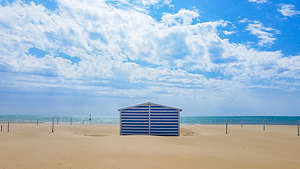 Strolling along the Narbonne PlageBefore leaving San Sebastian, I called Camping Bungelows San Anton, a campground in the Spanish Pyrenees, to see if they had room for us the next two nights. It was the nearest campground I could find to the start of the Cola de Caballo (Horsetail Waterfall), another of Spain’s classic hikes that we hoped to do.
Strolling along the Narbonne PlageBefore leaving San Sebastian, I called Camping Bungelows San Anton, a campground in the Spanish Pyrenees, to see if they had room for us the next two nights. It was the nearest campground I could find to the start of the Cola de Caballo (Horsetail Waterfall), another of Spain’s classic hikes that we hoped to do.
Unfortunately, I didn’t do my homework well enough. It wasn’t the season for hiking in the Pyrenees yet -- too cold and too much snow. The campground wasn’t even open yet. Oops.
When we removed the Pyrenees stop from Google Maps, it routed us through southern France to get to the Costa Brava coast of Spain, our next destination. We hadn’t planned to enter France at all and didn’t even have a guidebook. How exciting!
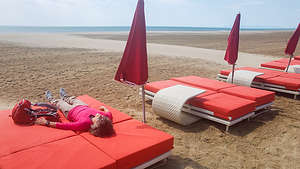 Lolo taking a break on our Narbonne Plage strollThe drive across southern France on A64 to Toulouse and then A61 to the Mediterranean coast was scenic and very expensive in terms of tolls. I think it was at least 50 €. However, they did have many free aires (places to camp overnight) in rest areas every 20 miles or so. We didn’t want to stay in a parking lot though - we had pretty much done that in San Sebastian last night. Instead we wanted to find something on the Mediterranean coast.
Lolo taking a break on our Narbonne Plage strollThe drive across southern France on A64 to Toulouse and then A61 to the Mediterranean coast was scenic and very expensive in terms of tolls. I think it was at least 50 €. However, they did have many free aires (places to camp overnight) in rest areas every 20 miles or so. We didn’t want to stay in a parking lot though - we had pretty much done that in San Sebastian last night. Instead we wanted to find something on the Mediterranean coast.
It wasn’t as easy as we thought. apparently, campgrounds in France don't necessarily mean that they have a place for camper vans. Rather you had to rent one of their fancy-smancy RVs or stay in a bungalow. Finally, we had the idea of using our ACSI camping app, which is for people traveling in camper vans, and found Camping Campeole La Cote des Roses on the Narbonne Plage.
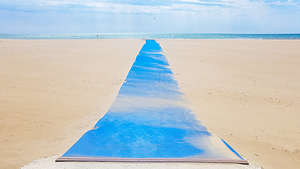 Highway to the MediterraneanIt was perfect. We got a pitch near a pretty lagoon along the access gate to the beach. We grabbed a bottle of wine, some cheese, and a blanket and walked the 400 meters to a beautiful wide beach, where we set up shop alongside a jetty. I even took a swim in the Mediterranean - my first in France.
Highway to the MediterraneanIt was perfect. We got a pitch near a pretty lagoon along the access gate to the beach. We grabbed a bottle of wine, some cheese, and a blanket and walked the 400 meters to a beautiful wide beach, where we set up shop alongside a jetty. I even took a swim in the Mediterranean - my first in France.
During the night the winds picked up in a big way, and were still doing so the next morning, precluding our plans of relaxing on the beach. So, we set off on a walk instead, hoping conditions would improve in the afternoon.
As we got out onto the beach, the sand was literally pelting us in the face -- a perfect day for the kiteboarders that were zipping up and down the shoreline. Too bad, because it was a really nice beach.
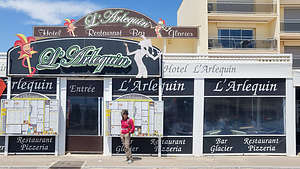 Lunch at L'ArlequinWe forged on to the pedestrian promenade, which was a little better because we were off the sand. The Narbonne Plage is a very popular resort area and the promenade had plenty of restaurants and bars to accommodate the large summer crowd.
Lunch at L'ArlequinWe forged on to the pedestrian promenade, which was a little better because we were off the sand. The Narbonne Plage is a very popular resort area and the promenade had plenty of restaurants and bars to accommodate the large summer crowd.
We stopped at a place called L’Arlequin which had great pizza and sangria. The Harlequin theme seemed to be pretty big in France- not exactly sure why, but I do know that lots of painters through the ages, such as Picasso and Cezanne have used Harlequins as their subjects.
On our walk back to the campground, the wind was still blowing really hard. In fact, the only activity besides kitesurfing going on were people racing up and down the beach on go-carts powered by sails. I guess we would just forget about spending time on the beach today.
Still I do get to add France to my list of countries visited, although I have a feeling a more thorough visit is in our future.
Description
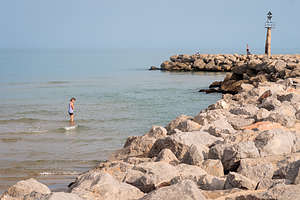 Jetty along the Narbonne PlageThe Narbonne Plage is a resort area on France’s southern (Mediterranean) coast that lies at the foot of the limestone massif Montagne de la Clape. It is a “blue flag” resort, meaning that it has been recognized for its environmentally conscious economic and tourist development.
Jetty along the Narbonne PlageThe Narbonne Plage is a resort area on France’s southern (Mediterranean) coast that lies at the foot of the limestone massif Montagne de la Clape. It is a “blue flag” resort, meaning that it has been recognized for its environmentally conscious economic and tourist development.
Its sandy beach is 5 kilometers long and 150 meters wide and is bordered by a 2.5 km long pedestrian promenade with many restaurants, bars, and shops.
San Sebastian
Saturday, June 8, 2019 - 11:30am by Lolo16 miles and 0.5 hours from our last stop - 1 night stay
Travelogue
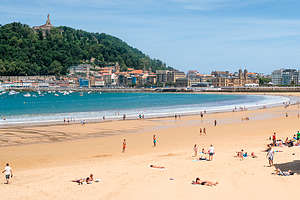 San Sebastian's lovely Playa de La ConchaContinuing our circumnavigation of Spain, we headed next towards the lovely Basque coastal town of San Sebastian, famous for beach and its food - best pintxos (tapas) in Spain.
San Sebastian's lovely Playa de La ConchaContinuing our circumnavigation of Spain, we headed next towards the lovely Basque coastal town of San Sebastian, famous for beach and its food - best pintxos (tapas) in Spain.
As in our Bilbao stop, there was no commercial campground in San Sebastian, but fortunately there was an “aires” (place to park an RV overnight), in walking distance to the beach and the old town. It’s called Donastia San Sebastian, which I guess is a bit repetitive as Donastia, is the Basque name for San Sebastian.
All my listening to Spanish tapes before this trip was pretty useless in Basque country as they speak Euskera (Basque) rather than Castellano (Castillian Spanish). Fortunately, all signs in the region are written in both.
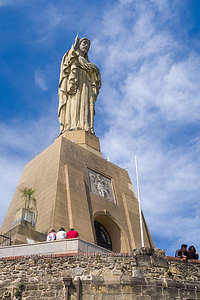 40-foot Jesus statue atop Mount UrgullIt was a Saturday, and the aires had only 40 spots, so we were very, very lucky to get the last one. We were stacked up like cordwood, but we didn’t plan to spend much time here anyway, as there was too much to see and do. Couldn’t complain too much, as we were in an excellent location and out site cost a whopping 6€.
40-foot Jesus statue atop Mount UrgullIt was a Saturday, and the aires had only 40 spots, so we were very, very lucky to get the last one. We were stacked up like cordwood, but we didn’t plan to spend much time here anyway, as there was too much to see and do. Couldn’t complain too much, as we were in an excellent location and out site cost a whopping 6€.
After a quick lunch in the van, we headed out to explore the city. We started by strolling the Concha promenade, which runs for 2 miles along the lovely, crescent-shaped Playa de La Concha beach, considered one of finest city beaches in all the world. The beach is about a mile long and capped on either end by the twin mountain peaks of Mount Igueldo and Mount Urgull, which we planned to climb later.
It was a Saturday afternoon, so as expected the promenade and beach were crowded with people out enjoying the beautiful day.
Coming from New Jersey, where a beach promenade is a boardwalk full of carnival rides and games, tacky souvenirs, and cotton candy and ice cream vendors, this was a very different experience.
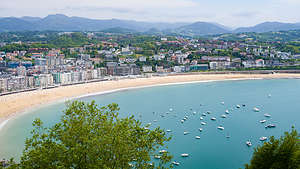 View of La Playa de La Concha from atop Mount UrgullIt was more of an elegant work of art. The white wrought-iron balustrade that runs the length of the promenade was designed by Juan Rafael and is so beautiful that it has become a symbol of the city. There are also elegant lampposts and los relojes” (clocks), which mark the main access to the beach.
View of La Playa de La Concha from atop Mount UrgullIt was more of an elegant work of art. The white wrought-iron balustrade that runs the length of the promenade was designed by Juan Rafael and is so beautiful that it has become a symbol of the city. There are also elegant lampposts and los relojes” (clocks), which mark the main access to the beach.
On the other side of the street from the beach are upscale businesses and apartments.
The beach was just too tempting to pass up, so we sat for about an hour or two on the towels we had stuffed into our backpacks and people watched.
There was also lots of intricate sand art, many of which made political statements about Basque independence.
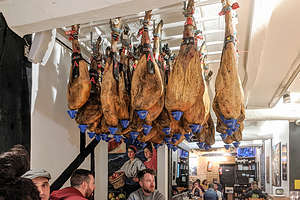 Now that's a lot of jamon - Baztan Pintxos and BarAfter the beach, we continued along the promenade to the Old Town Port Area and the start for the hike up Mount Urgull. There were many turnoffs and options along the way, but we just kept heading up towards the Castillo de La Mota, the 12th century castle on the summit.
Now that's a lot of jamon - Baztan Pintxos and BarAfter the beach, we continued along the promenade to the Old Town Port Area and the start for the hike up Mount Urgull. There were many turnoffs and options along the way, but we just kept heading up towards the Castillo de La Mota, the 12th century castle on the summit.
We paid to go in, but nothing was in English so it was difficult to understand its history. However, there was a video playing showing the many festivals and events that are held in San Sebastian throughout the year that we were able to understand.
Also, at the summit is a 40-foot-tall statue of Jesus looking out protectively over the harbor. This statue is so large that it can be seen from anywhere on the beach.
The views from the castle of La Concha Bay and the Old Town were stunning.
 Yummy dinner at the Baztan Pintxos and BarThere was lots of activity on the mountain as vendors scurried around with food and beer, preparing for a concert that was to take place later that night.
Yummy dinner at the Baztan Pintxos and BarThere was lots of activity on the mountain as vendors scurried around with food and beer, preparing for a concert that was to take place later that night.
We headed back down the mountain towards the Parte Vieja, San Sebastian’s charming old town, and began the quest for the perfect pintxos bar. While some looked really good, Herb insisted we continue our search until we found the perfect one. I was getting hungry and cranky, but he was right in holding out, because we eventually found Baztan Pintxos are Bar. It was perfect - Jamon hanging from the ceiling, and dozens of delicious looking pintxos choices covering the entire bar.
It was unbelievable.
Feeling that we had really gotten a good taste (no pun intended) of the beautiful city of San Sebastian, we traced our way back along the Concha Promenade and up past the university to our little home on wheels.
Description
San Sebastian is a coastal city located in the Basque region of Spain, just 12 miles from the French border. Its golden beaches and world-class pinxtos (tapas) bars have made it a very popular tourist destination. It has earned its reputation as the “Pearl” of northern Spain.
Some of its highlights include:
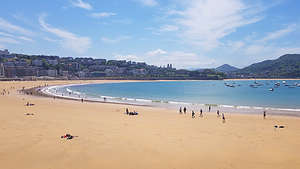 Looking the other direction on La Playa de La Concha
Looking the other direction on La Playa de La Concha
- The Playa de La Concha is considered one of the finest city beaches in the world, with its magnificent crescent-shaped, golden sand capped by twin mountain peaks at either end. A lovely two-mile beachfront promenade runs the length of the bay.
- The Parte Vieja is San Sebastian’s charming old town, famous for its world-class pintxos (tapas) bars. Its main square, the Plaza de la Constitucion, is one of the most attractive city squares in Basque Country. It was once used as a bullring and the balconies of the houses surrounding it were rented to spectators.
- Mount Urgull rises above the eastern end of the Playa de La Concha. You can walk to its summit by taking a path from Mari Street in San Sebastian’s (aka Donostia’s) Old Town Port Area. At the top you are rewarded with the Castillo de La Mota, a 12th-century fortress; a 40-foot-tall statue of Christ looking out over the harbor; and stunning viewpoints of the Old Town and La Concha Bay.
While there are no official commercial campgrounds in Bilbao, there is an aire (place for campers to park overnight) in the city. It is called Donostia San Sebastian and it is located just 1 km from the Playa de La Concha . It costs 6€ per night.
Getaria
Saturday, June 8, 2019 - 9:45am by Lolo52 miles and 1.25 hours from our last stop
Travelogue
 Tiny fishing village of GetariaRather than drive directly to San Sebastian, which would have been a little over an hour, we exited the AP-8 toll road onto N-634 to take a scenic diversion along the rocky coastline to the tiny fishing village of Getaria.
Tiny fishing village of GetariaRather than drive directly to San Sebastian, which would have been a little over an hour, we exited the AP-8 toll road onto N-634 to take a scenic diversion along the rocky coastline to the tiny fishing village of Getaria.
Rather than drive into the village, which sits high above the harbor, we drove down to the harbor to sniff the sea and look at the fishing boats. While there, we watched a rowing team practicing in the harbor. Rowing is very popular in Spain and even small villages often have their own teams.
It was a lovely diversion, but it did make me a bit homesick for the many fishing villages I loved in the East Coast on Cape Cod and Martha's Vineyard.
Description
 Tiny fishing village of GetariaGetaria is a tiny fishing village on the rocky coastline between Bilbao and San Sebastian. It’s a great example of coastal Basque town. The old village sits above a small harbor where there is a small crescent beach. At the end of the harbor there is a forested island called El Raton (the Mouse).
Tiny fishing village of GetariaGetaria is a tiny fishing village on the rocky coastline between Bilbao and San Sebastian. It’s a great example of coastal Basque town. The old village sits above a small harbor where there is a small crescent beach. At the end of the harbor there is a forested island called El Raton (the Mouse).
To reach it, you have to exit the AP-8 toll road onto N-634
Bilbao
Friday, June 7, 2019 - 9:30am by Lolo116 miles and 2.5 hours from our last stop - 1 night stay
Travelogue
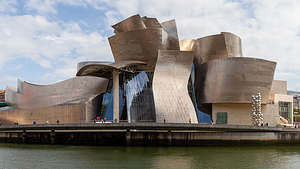 Bilbao Guggenheim MuseumOne of my favorite parts of travel is variety and the contrast of wildly different experiences. Today would be just that, as we started our day in the pristine natural beauty of the Picos de Europa and would end it in an old industrial city, also with plenty of beauty, but of the man-made kind.
Bilbao Guggenheim MuseumOne of my favorite parts of travel is variety and the contrast of wildly different experiences. Today would be just that, as we started our day in the pristine natural beauty of the Picos de Europa and would end it in an old industrial city, also with plenty of beauty, but of the man-made kind.
The drive to Bilbao was about 2 ½ hours, much of it a repeat of our side trip to Santillana del Mar. We were in a bit of a hurry as we wanted to secure a spot for the night in an Aires, called the Area de Autocaravanas de Kobetamendi, located in Bilbao. Otherwise, there really wasn’t much of an alternative as there are no commercial campgrounds in, or even near, the city.
As I mentioned in my overview, Aires are inexpensive (often free) places where overnight parking for camper vans is permitted. Most of them providing electricity, water fill, and waste disposal. Almost every city, large or small, has one located in either walking distance or near a bus stop to the major attractions of that city.
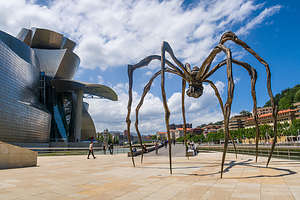 "Maman," the 30-foot spiderThe one in Bilbao was supposed to be one of the better ones in that it had a wonderful panoramic view overlooking the city and was located very close to a bus stop. It cost 15€ per night and included electricity and WiFi.
"Maman," the 30-foot spiderThe one in Bilbao was supposed to be one of the better ones in that it had a wonderful panoramic view overlooking the city and was located very close to a bus stop. It cost 15€ per night and included electricity and WiFi.
We got there by 11 am, about the time when people were leaving, so we had no trouble getting a spot, and it was a good one in that we had a great panoramic view out over the city. We could even see a little bit of the Guggenheim museum.
Another wonderful amenity in this Aires is that they had warm fresh bread every morning - something which I forgot to mention is a staple of every campground in Spain. Pretty much every morning of our trip so far, the first sight I would see when I woke up and looked out the window were men in bathrobes carrying baguettes.
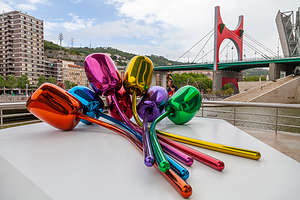 Jeff Koons’ giant roof-top “Tulips”But I digress. Back to the fascinating city of Bilbao.
Jeff Koons’ giant roof-top “Tulips”But I digress. Back to the fascinating city of Bilbao.
After a lunch of sandwiches on our fresh Aires’ bread, we walked the short distance down the hill to the bus stop which would bring us to the Nervión River, along which we could walk about a mile to the Guggenheim Museum. We got to see a bit of the non-touristy part of the city during our bus drive, and it was quite a contrast to the cities we had been to so far - much grittier, poorer, and more industrial. Plus, we were in Basque country now, so the language was different than the Spanish we had heard in the rest of the country - lots of x’s and k’s.
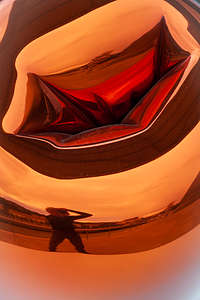 "Tulip" reflectionsThe walk along the river was nice, and there was much activity as people were setting up for the World Stand Up Paddleboard Challenge, which was to start the following day. As a result, there were lots of paddle boarders in the river practicing or just goofing off before the big day.
"Tulip" reflectionsThe walk along the river was nice, and there was much activity as people were setting up for the World Stand Up Paddleboard Challenge, which was to start the following day. As a result, there were lots of paddle boarders in the river practicing or just goofing off before the big day.
Of course, our destination for the day -- as it was every other tourist in the city -- was the famous Guggenheim Museum, designed by Canadian-American architect Frank Gehry and opened in 1997. The museum, with its gleaming titanium tiles that sheathe the exterior like giant herring scales, single-handedly transformed Bilbao from an industrial wasteland of gritty factories and shipyards into an international art and tourist destination.Having seen it so many times in photos, it was still such a thrill to actually see it in person.
As we approached the museum, we came upon a 30-foot spider on the terrace along the riverbank. Her name is Maman, which means “Mommy” and the artist that created her is Louise Bourgeois, a French-American artist. As we strolled beneath her spindly legs, Herb pointed upward at its belly, where there was an egg sac of marble eggs.
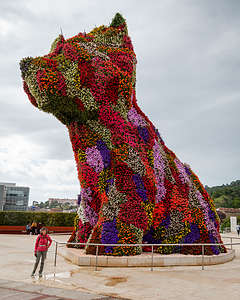 Koons' "Puppy"When we entered the museum, we found ourselves in an incredible 45-meter-high Atrium, with curved volumes and large glass curtain walls connecting the inside and the outside. There were no straight lines to be found here, which is one of the signature traits of Gehry’s architectural design. The three levels of the building, and its 20 galleries, are organized around the Atrium and connected via curved walkways, staircases, and titanium and glass elevators.
Koons' "Puppy"When we entered the museum, we found ourselves in an incredible 45-meter-high Atrium, with curved volumes and large glass curtain walls connecting the inside and the outside. There were no straight lines to be found here, which is one of the signature traits of Gehry’s architectural design. The three levels of the building, and its 20 galleries, are organized around the Atrium and connected via curved walkways, staircases, and titanium and glass elevators.
We took the elevator to the third floor, so that we could start at the top galleries and wander back down. I have to say though that as impressed and awed as we were by the architecture - both inside and out - we were not so much by the actual works of art, with some exceptions, on display. In fact, one of the criticisms of this museum is that the architectural structure overwhelms its function as a place to display artwork. People come to see that more than its contents. In any case, it is an amazing experience to wander through.
One of my favorite artworks in the museum is Jeff Koons’ “Tulips,” a gigantic stainless steel bouquet of colorful flowers located on a terrace off the atrium that overlooks the river. The flowers are over 2 meters tall and 5 meters across. The reflections of the museum and its visitors in its shiny surface create a very interesting funhouse mirror effect.
 Pintxos (tapas) in the Plaza NuevaKoons has another piece outside the main entrance to the museum named “Puppy.” It’s 42-foot-tall, highland terrier, made from over 60,000 plants and flowers that grow through a steel mesh framework. Puppy was supposed to be a temporary visitor, but the people of Bilbao fell in love with it and bought it. I, for one, am glad they did.
Pintxos (tapas) in the Plaza NuevaKoons has another piece outside the main entrance to the museum named “Puppy.” It’s 42-foot-tall, highland terrier, made from over 60,000 plants and flowers that grow through a steel mesh framework. Puppy was supposed to be a temporary visitor, but the people of Bilbao fell in love with it and bought it. I, for one, am glad they did.
We crossed the River Nervión on the Puente La Salve and walked north a bit for what turned out to be the best views of the exterior of the Guggenheim. On this side of the river, there was much more graffiti - some just artistic expressions, but others of a more political nature. Apparently, the Basque country, also had activists in a separatist movement from the rest of Spain (similar to what we had seen in Barcelona). "We are not Spain!" was painted on many a wall.
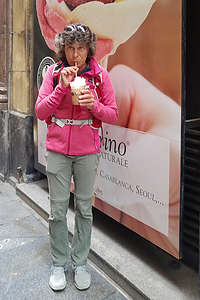 Lolo enjoying her birthday cafe con helado (ice cream)We continued on towards the Casco Viejo, Bilbao’s old city. That is definitely something European cities have that we don’t in the states - “casco viejos,” or old towns. The U.S. simply isn’t old enough. And, my favorite places in each of the casco viejos we have visited are the plazas, where families and friends come to gather in the evenings, especially on Friday evenings, as this was.
Lolo enjoying her birthday cafe con helado (ice cream)We continued on towards the Casco Viejo, Bilbao’s old city. That is definitely something European cities have that we don’t in the states - “casco viejos,” or old towns. The U.S. simply isn’t old enough. And, my favorite places in each of the casco viejos we have visited are the plazas, where families and friends come to gather in the evenings, especially on Friday evenings, as this was.
Herb and I grabbed a table alongside the Plaza Nueva, and ordered some tapas (called pintxos in Basque country) in a local bar. It was a great place to people watch. Kids from age 5 to probably 15 were playing soccer in the square. Every kid in Spain seems to always be carrying a soccer ball. The people at the table next to us took out little books that looked like hymn books and starting singing in Basque. It was pretty magical.
Although we tried to blend in, somehow I think everyone knew we were Americans - not sure I exactly know why, and not sure I want to. After dinner, I went to pose for a picture on the square, and as I did so, a young boy probably no older than 7, said in not great, but understandable English, “Can you please move, you are in our goal.” Oops. How did he know I was an American. Perhaps it was because I was oblivious to the fact that I was standing in their goal posts.
Before heading back to the bus stop, I stopped at a cafe to have what has become one of my favorite drinks of the trip - cafe con helado (ice cream) with lots of whip cream on top. It was my birthday, so I deserved it.
Description
Once an industrial wasteland of gritty factories and shipyards, the city of Bilbao has been transformed into an international art and tourist destination. It is one of the great treasures of Spain’s Basque Country, a region that often considers itself separate from Spain and even has its own language.
Guggenheim Museum
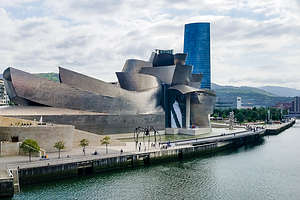 Bilbao Guggenheim MuseumFor most visitors, the Guggenheim Museum is the main draw, and it has played a major role in lifting Bilbao out of its postindustrial depression.
Bilbao Guggenheim MuseumFor most visitors, the Guggenheim Museum is the main draw, and it has played a major role in lifting Bilbao out of its postindustrial depression.
Designed by Canadian-American architect Frank Gehry and opened in 1997, this museum of modern and contemporary art is one of modern architecture’s most iconic buildings, with its gleaming titanium tiles that sheathe the exterior like giant herring scales, reflecting the colors that light projects onto it.
Critics have said that the structure overwhelms function in that it is most famous and loved for its architecture rather than the art contained within it, which is considered no better than other art museums in Europe.
As you enter the Museum, you enter the 45-meter-high Atrium, with curved volumes and large glass curtain walls connecting the inside and the outside. There are no straight lines to be found here, one of the signature traits of Gehry’s architectural design. The three levels of the building are organized around the Atrium and connected via curved walkways, staircases, and titanium and glass elevators. The Atrium functions as an axis for the museum’s 20 galleries.
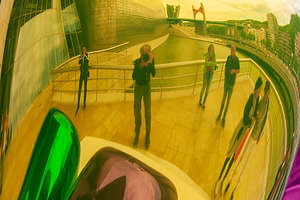 More "Tulip" reflectionsOther artists have added their touch to this amazing museum. Outside on the terrace along the riverbank lives Maman (“Mommy”), a 30-foot spider by French-American artist Louise Bourgeois.
More "Tulip" reflectionsOther artists have added their touch to this amazing museum. Outside on the terrace along the riverbank lives Maman (“Mommy”), a 30-foot spider by French-American artist Louise Bourgeois.
Guarding the main entrance is Jeff Koons’ 42-foot-tall, highland terrier “Puppy,” made from over 60,000 plants and flowers that grow through a steel mesh framework. Although originally intended to be temporary, the people of Bilbao fell in love with it and bought it.
Another piece by Koons is Tulips, a colorful stainless steel giant bouquet of seven tulips located on a terrace off the atrium overlooking the river. The flowers are huge - more than 2 meters tall and 5 meters across. The reflections of the museum and its visitors in its shiny surface create a fun house mirror effect.
The museum is open from 10 am - 8 pm every day but Monday.
Casco Viejo (Old Town)
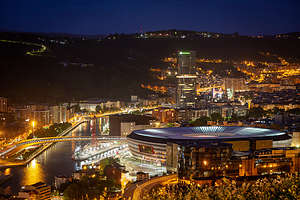 View of Bilbao from the back of our camperSouth of the Guggenheim Museum on the other side of the Ria de Bilbao is the city’s old quarter, with its tight labyrinth of charming old stone lanes, a 14th-century Gothic Cathedral, the 19th century Plaza Nueva, and boisterous tapas (called pintxos here) bars.
View of Bilbao from the back of our camperSouth of the Guggenheim Museum on the other side of the Ria de Bilbao is the city’s old quarter, with its tight labyrinth of charming old stone lanes, a 14th-century Gothic Cathedral, the 19th century Plaza Nueva, and boisterous tapas (called pintxos here) bars.
Camping in Bilbao
While there are no official commercial campgrounds in Bilbao, there is an aire (place for campers to park overnight) in the city. It is called Area de Autocaravanas de Kobetamendi, and it is located atop a hill with panoramic view of Bilbao. It costs 15€ per night and includes electricity and WiFi. A bus stop into the city is located a short distance down the hill.
Santillana del Mar and the Altamira Cave
Wednesday, June 5, 2019 - 10:15am by Lolo94 miles and 2 hours from our last stop
Travelogue
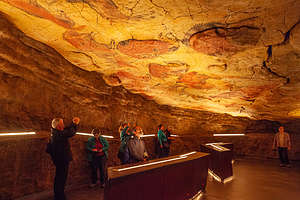 Altamira Museum and CaveRainy days can be good sometimes, because they force you to do something different. If today had been sunny we would be on the Ruta del Cares trail right now -- which, don’t get me wrong, would have been great, and is hopefully something we would do tomorrow. Instead, we were heading to the tiny little village of Santillana del Mar.
Altamira Museum and CaveRainy days can be good sometimes, because they force you to do something different. If today had been sunny we would be on the Ruta del Cares trail right now -- which, don’t get me wrong, would have been great, and is hopefully something we would do tomorrow. Instead, we were heading to the tiny little village of Santillana del Mar.
During our time in Spain so far, we had been to cities of all shapes and sizes - from Barcelona to Granada to Cordoba to Salamanca to Ronda - and they were all great in their own way, but I was about ready for a tiny village, so Santillana del Mar, with a population of 4,000 and only three cobblestone streets to wander navigate sounded like a welcome change.
Before getting to the village, we took the turnoff for the Altamira Cave Museum to check out a different kind of art than that which we had been exposed to so far along our journey through Spain.
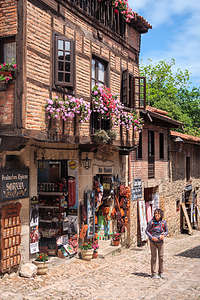 Lolo wandering along the cobblestone streets of Santillana del MarAltamira is pretty much synonymous with prehistoric cave paintings, and for good reason. If you’ve ever seen pictures of cave walls and ceilings covered with paintings of bison, horses, and deer, it was probably Altamira.
Lolo wandering along the cobblestone streets of Santillana del MarAltamira is pretty much synonymous with prehistoric cave paintings, and for good reason. If you’ve ever seen pictures of cave walls and ceilings covered with paintings of bison, horses, and deer, it was probably Altamira.
The Altamira Cave was discovered in 1879 by the young daughter of a local archaeologist. The paintings are over 14,000 years old and considered to be the best examples of prehistoric art in the world
As you might expect, it became a very popular tourist destination, so much so that in 2002, the cave was closed to the public in order to prevent further deterioration of the art.
However, today there is a museum and a replica cave, allowing visitors such as us to experience it as if it were real. It was quite amazing.
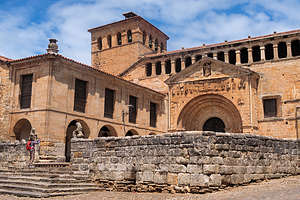 Romanesque Church in village of Santillana del MarFrom there, we drove less than two miles to the village of Santillana del Mar and found parking at an “Aires.” As I mentioned in my Trip Overview, Aires are inexpensive (and often free) places where overnight parking for camper vans is permitted. This particular one didn’t have any services, but it was in a nice rural setting, free, and very close to town. We didn’t need overnight parking, but it served the purpose of providing us a place to park for a few hours.
Romanesque Church in village of Santillana del MarFrom there, we drove less than two miles to the village of Santillana del Mar and found parking at an “Aires.” As I mentioned in my Trip Overview, Aires are inexpensive (and often free) places where overnight parking for camper vans is permitted. This particular one didn’t have any services, but it was in a nice rural setting, free, and very close to town. We didn’t need overnight parking, but it served the purpose of providing us a place to park for a few hours.
It was a beautiful village, so peaceful and quiet compared to the crowds we had been encountering up to now. There are only three streets in the village, so it didn’t take us too long to see all its sites - the plaza, a stunning Romanesque church, the lovely honey-colored mansions with flower boxes in every window, and school children playing bullfight. The village was absolutely charming and for our tastes, the size was just right.
Description
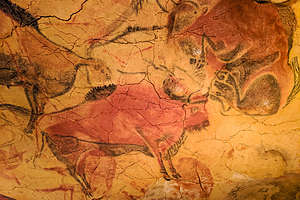 Altamira Museum and CaveSantillana del Mar is a lovely little stone village near the northern coast, in the province of Cantabria, one hour east of Picos de Europa and 1½ hours west of Bilbao.
Altamira Museum and CaveSantillana del Mar is a lovely little stone village near the northern coast, in the province of Cantabria, one hour east of Picos de Europa and 1½ hours west of Bilbao.
According to Jean-Paul Sartre, this village, consisting of three cobbled streets, a few squares, honey-colored mansions, and a stunning Romanesque Church, is “the prettiest village in Spain.”
Just 2.5 km south of the village is the Altamira Cave, whose 14,000 year old prehistoric cave paintings are world famous and considered to be one of the best examples of prehistoric art in the world.
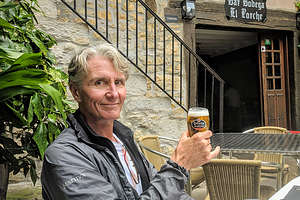 Beer break in Santillana del MarThis incredible cave whose walls and ceilings are filled with paintings of bison, horses, deer, and other animals was first discovered in 1879 by the young daughter of a local archaeologist. It became a very popular tourist destination, so much so that in 2002, the cave was closed to the public in order to prevent deterioration of the art.
Beer break in Santillana del MarThis incredible cave whose walls and ceilings are filled with paintings of bison, horses, deer, and other animals was first discovered in 1879 by the young daughter of a local archaeologist. It became a very popular tourist destination, so much so that in 2002, the cave was closed to the public in order to prevent deterioration of the art.
Now a museum and replica cave sit near the original site, allowing visitors to experience and appreciate these amazing examples of prehistoric art.
Parque Nacional de Los Picos de Europa
Tuesday, June 4, 2019 - 9:45pm by Lolo25 miles and 0.75 hours from our last stop - 3 night stay
Travelogue
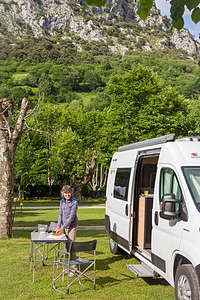 Our campground in the Picos de EuropaIt had been a long driving day - hard to believe we were in Salamanca just this morning. Then there was the side trip up the winding road to the Basilica de Covadonga, which was awesome by the way.
Our campground in the Picos de EuropaIt had been a long driving day - hard to believe we were in Salamanca just this morning. Then there was the side trip up the winding road to the Basilica de Covadonga, which was awesome by the way.
Herb was pretty beat from driving. That’s why I was pretty surprised when he agreed to my suggestion of checking out the trailhead and parking situation for the Ruta del Cares hike we were planning to do tomorrow, before we checked into our campground.
It didn’t look like a big deal on Google Maps, but it turned out to be another very winding road, which ended in very rough stones with no place to turn around - oops!. After an 8-point turn and some less than kind words, Herb got the van turned around and pointed to the campground, with the very strong suggestion of no more stops.
Well, at least we learned something. We would take a taxi to the trailhead and back.
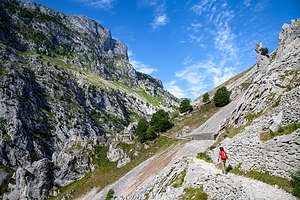 Lolo heading off on the Rute del Cares TrailFinally, around dinner time, we pulled into Camping Naranjo de Bulnes. As promised when I called them earlier, there were plenty of sites to choose from, as it was still early in the season.
Lolo heading off on the Rute del Cares TrailFinally, around dinner time, we pulled into Camping Naranjo de Bulnes. As promised when I called them earlier, there were plenty of sites to choose from, as it was still early in the season.
After spending so much time in cities, it was nice to once again be camping surrounded by natural beauty, which really is more our thing. The lovely mountain views and a nearby river quickly improved morale - a well-deserved beer didn’t hurt either.
The facilities were very nice and there was even a little WiFi to be had near the reception office.
All this was a plus, as the real reason we had chosen this campground was its proximity to the Ruta del Cares Trail (just 8 km away), one of the three epic hikes in Spain that I had selected during my research back home.
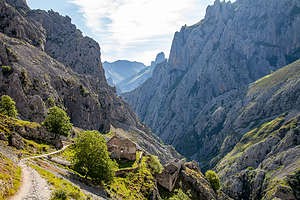 Along the Rute del Cares TrailHowever, the weather was not great, and the forecast for tomorrow was no better - pretty much rain and wind all day. Argghh! This would be the second time that our planned hike would be thwarted by weather. With the wind situation closing El Caminito del Rey last week, we just waited around another day and got it in. Hopefully, the same would happen here, and we would get a good day to hike the day after tomorrow.
Along the Rute del Cares TrailHowever, the weather was not great, and the forecast for tomorrow was no better - pretty much rain and wind all day. Argghh! This would be the second time that our planned hike would be thwarted by weather. With the wind situation closing El Caminito del Rey last week, we just waited around another day and got it in. Hopefully, the same would happen here, and we would get a good day to hike the day after tomorrow.
Like the El Camiito del Rey, the Ruta del Cares is another hike along a gorge with precipitous drop-offs, but unlike El Caminito del Rey, this one had no handrails. I definitely wanted good conditions to do it in -- like no big winds pushing me off..
Meanwhile we had a so-so weather day to kill. Fortunately, I had a plan. The little stone village of Santillana del Mar and the nearby Altamira caves had been on my list as a place to stop when we continued east to Bilbao. Although it was an hour away, we figured it was better than sitting in the van in the rain.
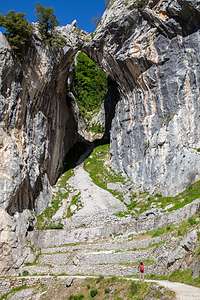 Along the Ruta del Cares trailIt turned out to be a really worthwhile destination, so much so that rather than describe that excursion here, I thought I would give it the dignity of its own stop - see next page for a description of our excursion to Santillana del Mar.
Along the Ruta del Cares trailIt turned out to be a really worthwhile destination, so much so that rather than describe that excursion here, I thought I would give it the dignity of its own stop - see next page for a description of our excursion to Santillana del Mar.
By the time we got back to the campground, the skies had cleared, and it was a very nice evening. Perhaps we would be able to hike the Ruta del Cares tomorrow.
Sure enough, the next morning the sun was shining and the winds were light. We packed up for the day and headed over to the campground office, where the girl that checked us in promised to call us a taxi to take us to the trailhead. After our trial run at driving to the trailhead the other day and having to do a 10-point turn on sharp rocks to get out of there, Herb had definitely decided that no matter how expensive the cab was, it would be worth it. It actually wasn’t bad - just 8 € each way.
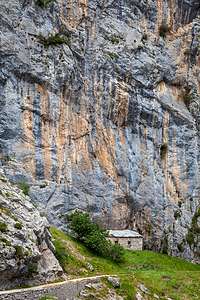 Along the Ruta del Cares trailAs we drove through the quaint little town of Asturia, our taxi driver kept beeping and sticking his arm out the window. At first I thought he was expressing his annoyance with other drivers, but then I realized that they were all beeping back and waving. They just all knew each other and were saying good morning.
Along the Ruta del Cares trailAs we drove through the quaint little town of Asturia, our taxi driver kept beeping and sticking his arm out the window. At first I thought he was expressing his annoyance with other drivers, but then I realized that they were all beeping back and waving. They just all knew each other and were saying good morning.
We said our goodbyes at the trailhead with the promise of calling him to retrieve us when we were done in about 6 or 7 hours.
I was pretty excited, as the Ruta del Cares is considered to be one of the most breathtaking trekking trails in all of Europe. We had already virtually experienced the trail by watching several YouTube videos, but nothing can compare to the real thing.
The 7.5-mile trail traverses the Picos de Europa National Parque, connecting the town of Poncebos (where we were) in the north to Cain in the South. Since it’s a 65 mile drive between the towns, most people do it as an out-and-back, which means it is really a 15-mile hike.
The first mile or so is a steady climb - the only along the otherwise relatively flat route. Once on top, the most beautiful part of the route begins and the stunning scenery just keeps on going all the way to Cain.
The trail, which was hacked out of the cliff face, runs alongside the Cares Gorge (appropriately nicknamed the Divine Gorge) with stunning limestone mountain peaks rising all around us.
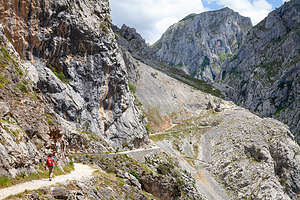 Along the Ruta del Cares trailWe had to be careful not to get too distracted with the scenery, because the footpath is quite narrow (less than 1 ½ meters) in places and precariously close to the edge, with a 1,000 meter drop straight down to the river. It was much scarier than the Caminito del Rey hike we had done earlier in the trip, as there were no handrails to prevent us from falling over the edge.
Along the Ruta del Cares trailWe had to be careful not to get too distracted with the scenery, because the footpath is quite narrow (less than 1 ½ meters) in places and precariously close to the edge, with a 1,000 meter drop straight down to the river. It was much scarier than the Caminito del Rey hike we had done earlier in the trip, as there were no handrails to prevent us from falling over the edge.
The scenery was so distracting that before we knew it we were at the other end. The final stretch into the tiny village of Cain led us through a series of tunnels chiseled out of the limestone and across a footbridge over the Cares River. The village was very quaint, with just a few restaurants and a cafe. Unfortunately the cafe was closed, destroying my dreams of having an American before hiking back.
On the way back the wind really started to pick up as it funneled through the gorge. This would make the narrow, precarious parts of the trail even more exciting. I found myself leaning in towards the wall and staying as far away from the edge as possible.
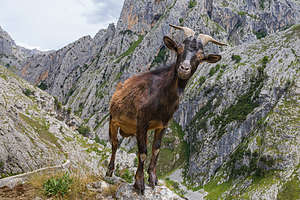 I'm not sure which one of us is more curiousWhen we were almost back to Poncebos, we encountered a few of the trail’s famous, friendly mountain goats, who were a lot less concerned about the wind than I was. No leaning into the cliff for them.
I'm not sure which one of us is more curiousWhen we were almost back to Poncebos, we encountered a few of the trail’s famous, friendly mountain goats, who were a lot less concerned about the wind than I was. No leaning into the cliff for them.
They certainly were not shy. They were so curious and anxious to interact that Herb spent a good half hour photographing them. There are more photos of goats than there are of me on this trip.
The hike had very much lived up to my anticipation of it. It was absolutely stunning, every inch of the way.
Back at the trailhead, we called our taxi driver who delivered us back to our campground, beeping and waving at everyone along the way.
Description
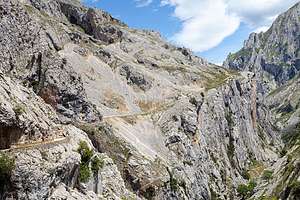 Along the Ruta del Cares trailPicos de Europa National Park contains some of Europe’s most spectacular scenery and some of Spain’s finest walking country. Its stunning limestone mountain peaks are the highest in Spain, and lie just 15 miles inland from the Atlantic Ocean.
Along the Ruta del Cares trailPicos de Europa National Park contains some of Europe’s most spectacular scenery and some of Spain’s finest walking country. Its stunning limestone mountain peaks are the highest in Spain, and lie just 15 miles inland from the Atlantic Ocean.
One of the most famous hikes in all of Spain is the Ruta del Cares in the Picos de Europa. The 7.5-mile trail runs alongside the Cares Gorge (nicknamed the Divine Gorge) along an amazing footpath hacked out of the cliff face, at the edge of the 1,000 meter deep gorge. At times the trail is rather narrow and a bit precariously close to the edge. It is considered to be one of the most breathtaking trekking trails in all of Europe.
The trail goes from the town of Poncebos in the north to Cain in the South.
The nearest camping to the start of the trail is Camping Naranjo de Bulnes in the town of Asturias (8 km from trailhead).
Basilica de Covadonga
Tuesday, June 4, 2019 - 2:30pm by Lolo240 miles and 4.5 hours from our last stop
Travelogue
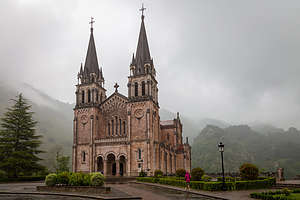 Basilica de CovadongaFrom the moment I saw a photo of the Basilica de Covadonga during my trip planning research, I knew I had to get there. Its beauty was haunting, especially during the atmospherics of a coming storm.
Basilica de CovadongaFrom the moment I saw a photo of the Basilica de Covadonga during my trip planning research, I knew I had to get there. Its beauty was haunting, especially during the atmospherics of a coming storm.
As we drove the 5 hours from Salamanca to our intended campground in Asturias, right outside the Picos de Europa National Park, I began strategizing how I could convince Herb that it was he that wanted to take the ½ hour side trip up a windy mountain to see the Basilica. The fact that it had started to drizzle didn’t make it any easier - or maybe in a way it did, because the photo that first got me going on this place was taken during just these conditions. That, plus my charm got him to make the turn.
There was a little bit of grumbling about where we would park when we got there, but no problem. We pulled right up and parked in front of it, as if we owned the place.
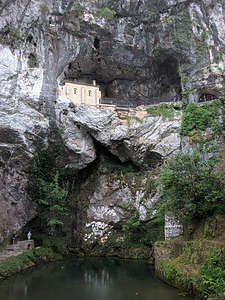 Santa Cueva, a hillside cave where, according to legend, the Virgin Mary appeared in 722 ADIt was even better in real life - a stunning pink granite, 19th century, neo-Romanesque basilica, set against the dramatic soaring mountains of the Picos de Europa - with a bit of mist and clouds to add to the atmospherics.
Santa Cueva, a hillside cave where, according to legend, the Virgin Mary appeared in 722 ADIt was even better in real life - a stunning pink granite, 19th century, neo-Romanesque basilica, set against the dramatic soaring mountains of the Picos de Europa - with a bit of mist and clouds to add to the atmospherics.
Unsure as to whether it was open, we tried the doors, and sure enough it was. We entered and found that we had it all to ourselves - so serene compared to the crowded cathedrals and monasteries we had been to so far along this trip.
After leaving the church, we walked down to the Santa Cueva, a hillside cave where, according to legend, the Virgin Mary appeared before a battle between the Christians and the Muslims in 722 AD. Her appearance spurred the Christian army on to victory and marked the beginning of the 800-year Reconquista. Today there is a beautiful chapel set inside the cave, which has now become a pilgrimage site.
This was definitely a very worthwhile stop.
Description
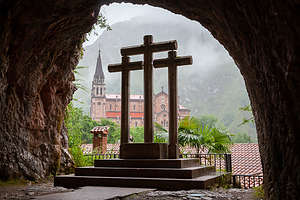 View of the Basilica from Santa CuevaThe Basilica de Covadonga, located 5 km up a steep, winding road in the remote northern Picos mountains, is an incredibly grandiose 19th-century, neo-Romanesque, pink granite basilica. Its beauty is even further enhanced by its dramatic setting, tucked between soaring mountains. It is a breathtaking sight.
View of the Basilica from Santa CuevaThe Basilica de Covadonga, located 5 km up a steep, winding road in the remote northern Picos mountains, is an incredibly grandiose 19th-century, neo-Romanesque, pink granite basilica. Its beauty is even further enhanced by its dramatic setting, tucked between soaring mountains. It is a breathtaking sight.
The significance of this location is that it was the site of the Muslims first defeat in Spain by the Christians, marking the beginning of the 800-year Reconquista. According to legend, before the battle, in 722 AD, the Virgin Mary appeared in a hillside cave, just a short walk from where the basilica is today. A chapel has been installed in the cave, known as the Santa Cueva.
Today it is still a pilgrimage site.
